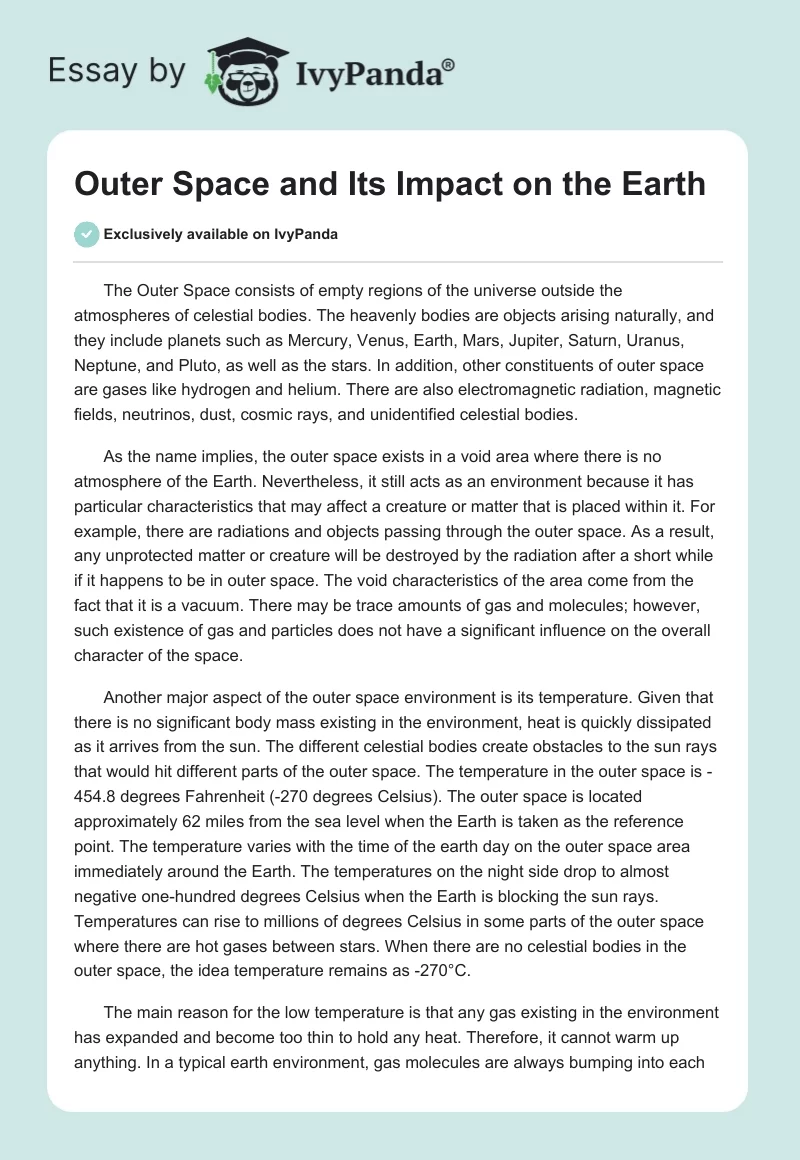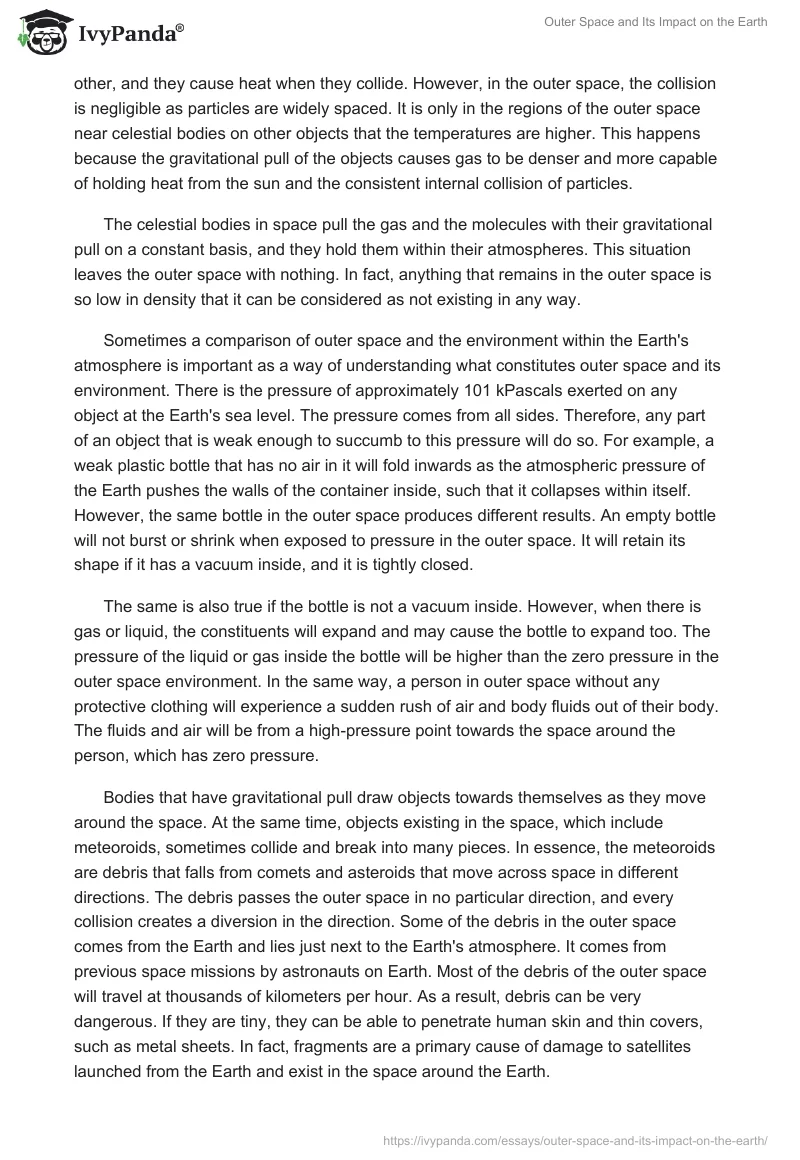The Outer Space consists of empty regions of the universe outside the atmospheres of celestial bodies. The heavenly bodies are objects arising naturally, and they include planets such as Mercury, Venus, Earth, Mars, Jupiter, Saturn, Uranus, Neptune, and Pluto, as well as the stars. In addition, other constituents of outer space are gases like hydrogen and helium. There are also electromagnetic radiation, magnetic fields, neutrinos, dust, cosmic rays, and unidentified celestial bodies.
As the name implies, the outer space exists in a void area where there is no atmosphere of the Earth. Nevertheless, it still acts as an environment because it has particular characteristics that may affect a creature or matter that is placed within it. For example, there are radiations and objects passing through the outer space. As a result, any unprotected matter or creature will be destroyed by the radiation after a short while if it happens to be in outer space. The void characteristics of the area come from the fact that it is a vacuum. There may be trace amounts of gas and molecules; however, such existence of gas and particles does not have a significant influence on the overall character of the space.
Another major aspect of the outer space environment is its temperature. Given that there is no significant body mass existing in the environment, heat is quickly dissipated as it arrives from the sun. The different celestial bodies create obstacles to the sun rays that would hit different parts of the outer space. The temperature in the outer space is -454.8 degrees Fahrenheit (-270 degrees Celsius). The outer space is located approximately 62 miles from the sea level when the Earth is taken as the reference point. The temperature varies with the time of the earth day on the outer space area immediately around the Earth. The temperatures on the night side drop to almost negative one-hundred degrees Celsius when the Earth is blocking the sun rays. Temperatures can rise to millions of degrees Celsius in some parts of the outer space where there are hot gases between stars. When there are no celestial bodies in the outer space, the idea temperature remains as -270°C.
The main reason for the low temperature is that any gas existing in the environment has expanded and become too thin to hold any heat. Therefore, it cannot warm up anything. In a typical earth environment, gas molecules are always bumping into each other, and they cause heat when they collide. However, in the outer space, the collision is negligible as particles are widely spaced. It is only in the regions of the outer space near celestial bodies on other objects that the temperatures are higher. This happens because the gravitational pull of the objects causes gas to be denser and more capable of holding heat from the sun and the consistent internal collision of particles.
The celestial bodies in space pull the gas and the molecules with their gravitational pull on a constant basis, and they hold them within their atmospheres. This situation leaves the outer space with nothing. In fact, anything that remains in the outer space is so low in density that it can be considered as not existing in any way.
Sometimes a comparison of outer space and the environment within the Earth’s atmosphere is important as a way of understanding what constitutes outer space and its environment. There is the pressure of approximately 101 kPascals exerted on any object at the Earth’s sea level. The pressure comes from all sides. Therefore, any part of an object that is weak enough to succumb to this pressure will do so. For example, a weak plastic bottle that has no air in it will fold inwards as the atmospheric pressure of the Earth pushes the walls of the container inside, such that it collapses within itself. However, the same bottle in the outer space produces different results. An empty bottle will not burst or shrink when exposed to pressure in the outer space. It will retain its shape if it has a vacuum inside, and it is tightly closed.
The same is also true if the bottle is not a vacuum inside. However, when there is gas or liquid, the constituents will expand and may cause the bottle to expand too. The pressure of the liquid or gas inside the bottle will be higher than the zero pressure in the outer space environment. In the same way, a person in outer space without any protective clothing will experience a sudden rush of air and body fluids out of their body. The fluids and air will be from a high-pressure point towards the space around the person, which has zero pressure.
Bodies that have gravitational pull draw objects towards themselves as they move around the space. At the same time, objects existing in the space, which include meteoroids, sometimes collide and break into many pieces. In essence, the meteoroids are debris that falls from comets and asteroids that move across space in different directions. The debris passes the outer space in no particular direction, and every collision creates a diversion in the direction. Some of the debris in the outer space comes from the Earth and lies just next to the Earth’s atmosphere. It comes from previous space missions by astronauts on Earth. Most of the debris of the outer space will travel at thousands of kilometers per hour. As a result, debris can be very dangerous. If they are tiny, they can be able to penetrate human skin and thin covers, such as metal sheets. In fact, fragments are a primary cause of damage to satellites launched from the Earth and exist in the space around the Earth.
Regarding the above considerations, the outer space will behave much like a vacuum, but it is not completely a vacuum. The small bodies and big bodies also exert different gravitational pulls that cause micro gravities and different areas within the environment. Scientists will continue to discover additional characteristics of outer space due to the advancements in technology. For example, the persistent radiation that exists in the environment may influence the structure of the rubbles left by comets and asteroids in the space. Currently, all efforts that include sending missions and people to space to understand the space happen under a joint law that arose as part of the outer space treaty signed in 1967.
There is no knowledge of any other space missions by any civilization that may exist outside the Earth. Moreover, the current research is on the characteristics of the out space, with significant inquiries being made in its environment, capacity, age, as well as any parameter that is yet to be discovered.


